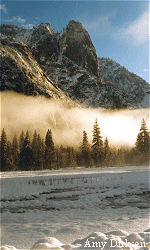 Winter WinterWinter climate in the Sierra is relatively mild although it is between November and March that 70-90% of the year’s total precipitation falls. The first snows of autumn are usually light and melt within a few hours or days, but by mid-November the ground is generally cold enough for snow to accumulate. At higher elevations, snow may fall as early as September or October. The snow pack increases during the winter months and reaches maximum depth in mid-March. In Yosemite Valley, the first snow of the season usually falls sometime after November 1. Yosemite Valley receives an average of 29 inches of snow during the entire winter season. Snow does not normally get over two feet deep in the Valley, although it has, on rare occassions, attained a depth of five feet. The last snow in the Valley generally comes before April 15.
Yosemite is well known for its waterfalls and cascades which are at their fullest during the time of melting snow and runoff. May and June are the best months for viewing the waterfalls of Yosemite Valley. Spring thaw works its way upslope from mid-May to mid-July when the last snow usually disappears from the higher peaks. Mule deer follow the retreating snowline back up into the park. The black oaks in Yosemite Valley begin to leaf out in April, the dogwoods bloom in early to mid-May, and western azalea bushes bloom in late May to early June.
Sierran summers are warm and dry with less than 5% of Yosemite’s total precipitation falling during summer months. Daytime temperatures in Yosmemite Valley sometimes reach 100 degrees fahrenheit during summer months, while nights are cool. Temperatures in Tuolumne Meadows (8,600 feet) in mid-summer are usually in the 70s (F) in the daytime and in the 30s at night. An intense blue summer sky may give way occassionally to sudden thunderstorms which can provide dramatically changing cloud formations, intense but brief downpours, lightning, thunder, hail, and gusty winds. Since waterfalls and streams are supplied by the melting snowpack, some are trickles or even completely dry in August. In drought years, some are dry by mid-July. Wildflowers appear in Tuolumne Meadows in July.
Nights grow increasingly cool while daytime temperatures continue to be warm through October or later. September and October typically bring a succession of clear, brilliant days. The warm, golden tones of the turning leaves of dogwood, cottonwood, maple and willow make a startling contrast to the granite walls of Yosemite Valley with autumn color reaching its peak in late October to early November. |
![]()
http://www.nps.gov
File created 9/99 Hayes Roberts
Updated
Yosemite National Park Division
of Interpretation